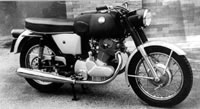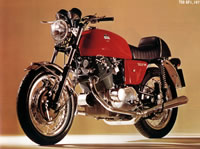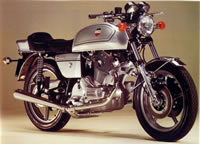BIG TWINS - THE 650 AND 750
 By
the early 1960's cars had become affordable enough that the small motorcycle
market was in decline and Massimo Laverda, Francesco's son and recent Mechanical
Engineering graduate, saw the opportunity to move into the production of
large motorcycles and the 1968 650 was the result. With five speed
transmission, unit construction engine, overhead camshaft and 'under-stressed'
nature it was a thoroughly modern engine, the 360 degree crankshaft was
the only similarity with the British twins of the era. The engines
external features were unquestionably influenced by the styling of the Honda
CB72 and for this it drew some criticism from those who still looked down
on the Japanese motorcycle industry. It was, is and always will be
a massively strong engine, the single overhead camshaft runs in no less
than four roller bearings and is driven by a duplex camchain, the crankshaft
runs in four ball bearings that would have done the Titanic's drive shaft
proud, drive to the clutch is by a monstrous triplex chain. Make no
mistake, this engine was built to LAST!
By
the early 1960's cars had become affordable enough that the small motorcycle
market was in decline and Massimo Laverda, Francesco's son and recent Mechanical
Engineering graduate, saw the opportunity to move into the production of
large motorcycles and the 1968 650 was the result. With five speed
transmission, unit construction engine, overhead camshaft and 'under-stressed'
nature it was a thoroughly modern engine, the 360 degree crankshaft was
the only similarity with the British twins of the era. The engines
external features were unquestionably influenced by the styling of the Honda
CB72 and for this it drew some criticism from those who still looked down
on the Japanese motorcycle industry. It was, is and always will be
a massively strong engine, the single overhead camshaft runs in no less
than four roller bearings and is driven by a duplex camchain, the crankshaft
runs in four ball bearings that would have done the Titanic's drive shaft
proud, drive to the clutch is by a monstrous triplex chain. Make no
mistake, this engine was built to LAST!
The bike quickly (within 52 machines!) grew to 750cc by virtue of increasing the bore from 75mm to 80mm and alongside the 750GT in 1969 came the 750S, marking the first of what we now recognise to be the 'sporting Laverdas'. The 750S soon found itself on the racetrack and by 1971 had been developed into the first of the very successful 750SFC's. Massimo's vision of cracking into the American market with the 750 was soured in the early stages when the bikes (GT's and S's) were launched under the 'American Eagle' banner, though I don't know the details apparently the marketing was a disaster and the bikes were caned by the press in the US while being praised in Europe and the UK. Very few 'American Eagles' were sold and worst of all, the bikes reputation suffered unfairly as a result. Not a good start.
 To
celebrate Laverdas patented new 2 leading shoe front drum brake the new
sports bike of 1970 was named the SF, denoting it's 'Super Freni' (brakes).
The new 'big valve' head and larger 36mm carburetors, were perhaps offset
by quieter exhaust and slightly lowered compression but none the less
it was a great sports bike. With a reputation for strength and reliability,
it was well received, especially by riders of British parallel twins pleasantly
surprised by a bike that neither leaked oil nor broke down!
To
celebrate Laverdas patented new 2 leading shoe front drum brake the new
sports bike of 1970 was named the SF, denoting it's 'Super Freni' (brakes).
The new 'big valve' head and larger 36mm carburetors, were perhaps offset
by quieter exhaust and slightly lowered compression but none the less
it was a great sports bike. With a reputation for strength and reliability,
it was well received, especially by riders of British parallel twins pleasantly
surprised by a bike that neither leaked oil nor broke down!
 The
SF was updated in 1973 (?) and unofficially became known as the SF1 with
Nippondenso instruments and the smooth tank and sidecovers that would
see out the 750 series. The SF1 was followed by the SF2 in 1974
which added twin Brembo disc brakes at the front to the Laverda drum at
the rear, other revisions were minor such as improved (ie Japanese) switchgear
and Bosch headlight.
The
SF was updated in 1973 (?) and unofficially became known as the SF1 with
Nippondenso instruments and the smooth tank and sidecovers that would
see out the 750 series. The SF1 was followed by the SF2 in 1974
which added twin Brembo disc brakes at the front to the Laverda drum at
the rear, other revisions were minor such as improved (ie Japanese) switchgear
and Bosch headlight.
In 1976 the SF3 was released with a seat and ducktail similar to the 3CL, along with cast wheels and a rear disc brake. By this stage the design was showing it's age, the triple was both lighter and more powerful and the competition from other European makes and of course the growing Japanese industry was strong. Sales were slow and production petered out in 1976.
The 750 is definitely an enthusiasts bike and they certainly combine a mixture of strength, character and speed that is not easily found in other bikes of the era. The 750 had served Laverda well, transforming it from a maker of small utility bikes into a recognised producer of the kind of big-bore sports bikes only the Italians know how to build.

